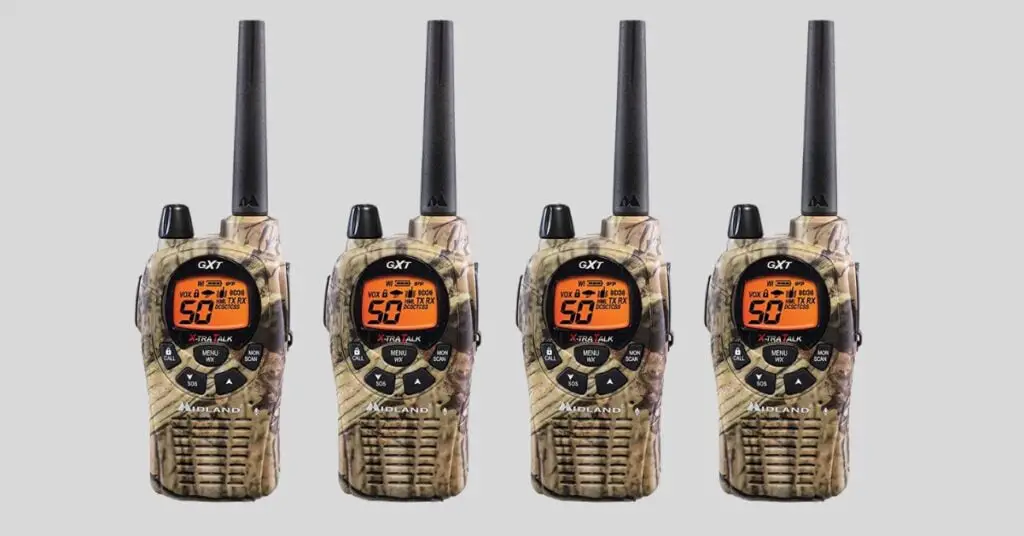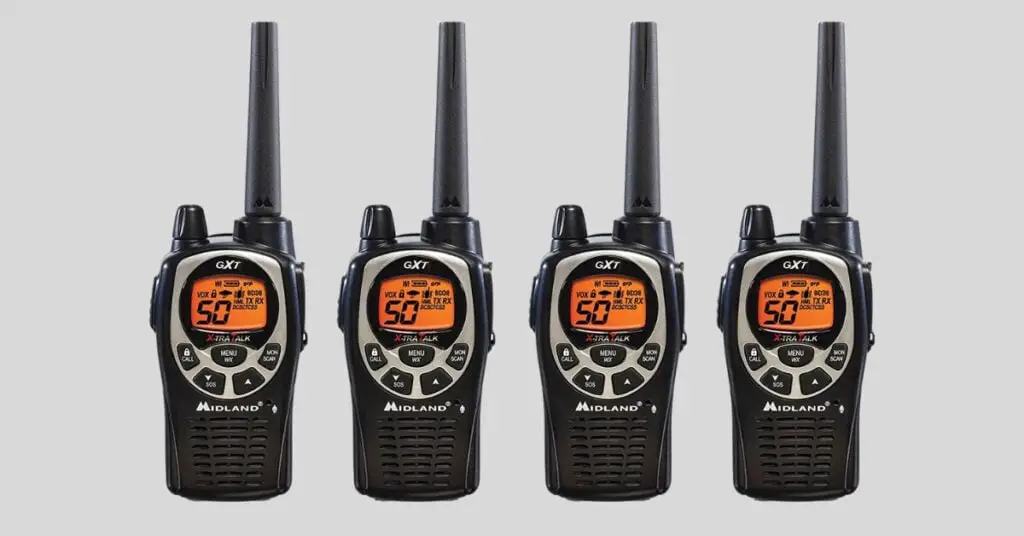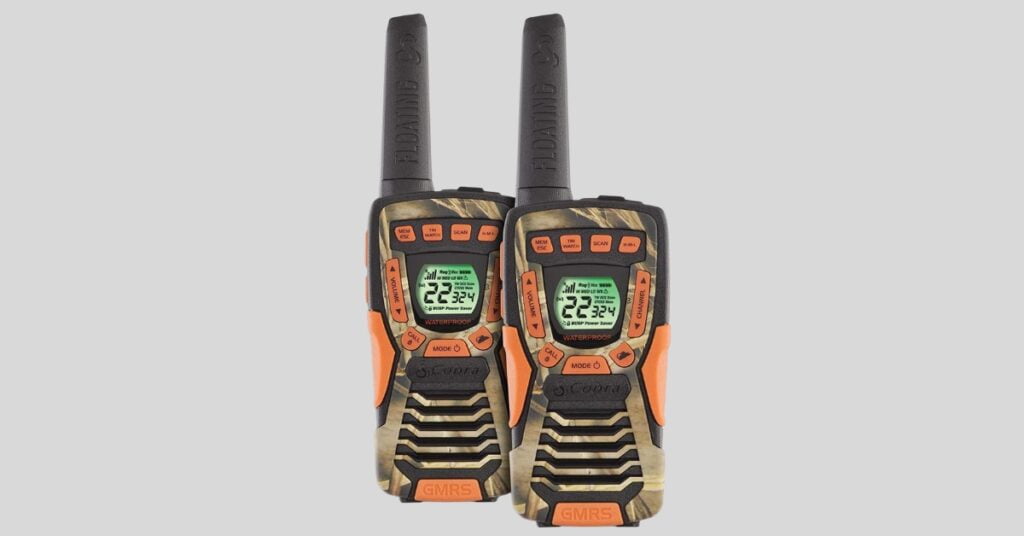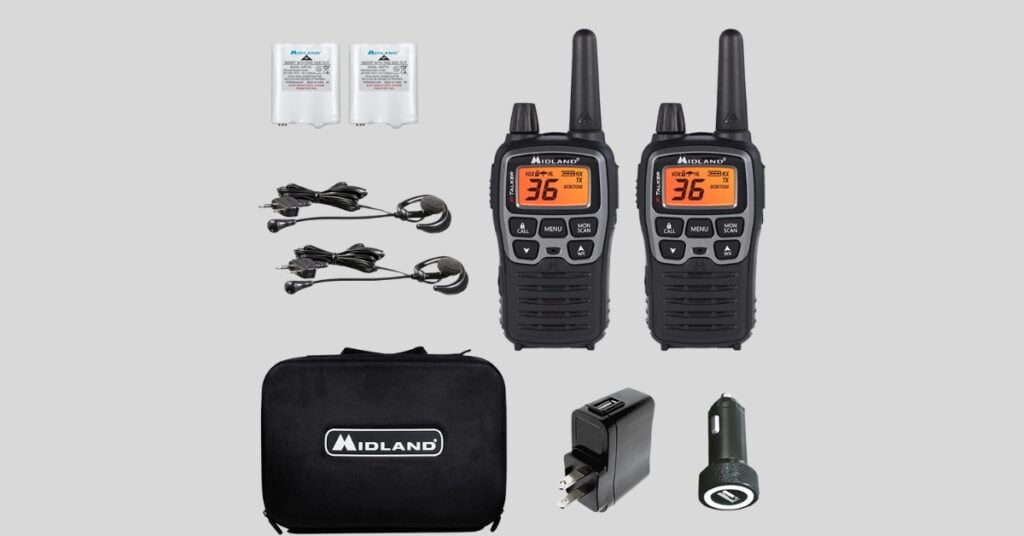Last updated on June 24th, 2023 at 02:50 am
This article will help you in choosing the Best Short Range Walkie Talkie with the help of User Test Pros and Cons. This also includes Keypoints, Key features, etc.
Introduction:-
Short Range Walkie Talkies, or two-way radios, are cheap ways for parties to communicate. Whenever cell phone service is spotty, you can use them to stay in touch with your family, and it can be useful while out on the water or in the wilderness.
Cell phones aren’t reliable for two-way communications in the wilderness – the best choice for hunting is two-way radios, which offer the most reliable coverage. Many manufacturers provide radio bundles so that you can buy two or six at a time.
Two-way radios provide another security measure when you are out of range of help, often many miles apart. Since they are so lightweight nowadays, there’s no excuse for not using them, so long as it’s allowed by law in your state.
Design
Product
Reason To Buy
Price

Midland GXT1050VP4 Long Range

Midland GXT1000VP4 36 miles

WATERPROOF Walkie Talkie FOR FISHING

Midland – X-Talker T77VP5
Generally, a Short Range Walkie Talkie is a handheld radio that communicates by transmitting radio waves. The units are equipped with a transmitter, a receiver, a loudspeaker, and a microphone that can be used to communicate. As intercoms, both use wire coils, magnets, and paper cones to create or receive sound.
1. Midland GXT1050VP4 Long Range Walkie Talkie

Midland’s GXT1050VP4 is the perfect accessory for any outdoor enthusiast. The two-voice-channel walkie-talkies provide crystal-clear reception, even in the most extreme weather conditions. With the illuminated LCD screen, the GXT1050VP4 will get your message across whether day or night.
This four-pack of two-voice-channel radios comes with the convenience of power-saving GMRS functionality. GMRS is a licensed radio service in the United States that allows you to receive priority channels; channels dedicated to police, firemen, and other public service organizations.
This adaptable radio is great for families, workgroups, or any group that need to stay in touch while outdoors. These portable two-way radios are the perfect accessory for any outdoor enthusiast.
Key Feature of Midland GXT1050VP4 Walkie Talkie
2. Midland GXT1000VP4 36 miles

“As part of our safety team, we use these during large church events, as well as outside events. We are very satisfied with the quality of the sound, the range, and the range, but we may consider something more concealed in the future.“
Key Feature of Midland GXT1000VP4 36 miles
3. WATERPROOF Walkie Talkie FOR FISHING

“The radios I use when racing are very nice. I use them in combination with helmet earpieces and microphones for communications. However, I can attest that they cannot achieve a range of 37 miles.
After 5000 feet, they work very well and then only transmit static. Ideally, they would receive more signals if I had an exact line of sight, but trees and hills can interfere with the signals in my area.
Despite the fact that I do not intend to drop them overboard, it is inevitable that things will get wet on a boat.“
Key Feature WATERPROOF Walkie Talkie FOR FISHING
4. Midland – X-TALKER T77VP5

“So in November of 2017, my brother and I were hunting in upstate NY. Sunday afternoon while walking out of the woods I dropped my Midland X-Talker T75VP3, when I got back to the truck it was nowhere to be found. Anticipating hunting season in 2018 I purchased another pair of X-Talkers.
Then while back in the woods in July of 2018 to set up some trail cameras, there it was on the ground in the middle of 52 hundred acres of steam mill state forest, my Midland X-Talker. When I got home I put fresh batteries in it and it worked like a charm.
After being in the woods for 9 months through a very harsh New York winter, spring, and half the summer. Thanks, Midland for making a quality walkie-talkie.“
Key Feature of Midland – X-Talker T77VP5
Wireless devices can perform both functions if their circuits are reversed simultaneously with the way they are configured. Today’s Short Range Walkie Talkie is equipped with speaker and microphone functions.
Originally, these radios were known as two-way transmitters or pack sets. Because they are portable, however, they quickly became popular for both talking and walking simultaneously. Batteries are used for all handsets. They come with a transmitter (that can be used as a receiver), an antenna, a loudspeaker (that can be used as a mic), and a button.
Speakers and microphones are essentially the same when it comes down to magnets, coils, and cone materials, so they can be combined into one device, depending on whether the current flows in one direction or the other. A more sophisticated model has different features.
A Short Range Walkie Talkie can only communicate with another walkie-talkie on the same channel, so it is imperative that the handsets are set to receive and that the loudspeakers are set to transmit and receive. In the absence of conversation, the devices will probably be broadcasting. The loudspeaker’s push-to-talk button turns the loudspeaker to the microphone when someone wants to talk, eliminating the static sound.
Radio waves fall within the electromagnetic spectrum and, as a result, travel at the speed of light (186,000 mph). Other handsets intuitively pick up the radio waves, which are transformed into electrical vibrations or fluctuating currents and then broadcasted. Short Range Walkie Talkies are two-way radios, so they allow both sending and receiving information at the same time. Since both functions utilize the same channel, there is only one set to configure person can talk at a time.
To avoid radio interference, most two-way radios today allow users to operate on multiple channels. However, radio transmitters must be able to generate waves of different frequencies to accomplish this. They are powered by batteries, transmit and receive messages over radio frequencies, and operate using a storm.
Approximately 186,000 mph is the speed of light for radio waves. So you can hear static on an untuned radio if it’s on! It does not matter what terrain the Short Range Walkie Talkie is on. As long as it uses the same frequency band, everyone can talk for miles. All users of the same frequency band will speak simultaneously since they will be sharing the same band.
Once you have reached the end, when you finish, wave your phone so it returns to listening. Several small businesses, rescue teams, and the military prefer using two-way radios for reasons related to ‘group talk’ and poor mobile signal reception.
How to use walkie talkie:-
Each Short Range Walkie Talkie must operate on the same frequency band. They can, however, hiss sporadically because their radios are receiving as if they were turned into a typical radio without any specific station tuned into it. In the event of radio silence, people switch from using the loudspeaker to using a microphone. To transmit their voice, speakers convert their words into radio waves, which are then converted back into electrical voltages by the transmitter.
The Short Range Walkie Talkie is a two-way radio that enables two-way conversation. Short Range Walkie Talkie has two-way audio, unlike radios with only one-way audio. Due to the need for only one source of frequency, this system is limited to one person communicating with the other person. Half-duplex communications are referred to as half-duplex communications. Your family and yourself are connected in an emergency with the mh30r.
No matter what happens, you’ll still be able to get weather alerts and communicate with your community even when your power is out, or your cell towers are down. What to do if you lose control or cellular towers go down? You will still be able to pick up weather alerts and communicate with those in your community, thanks to your radio.
Components Of walkie talkie:-
All radio communication devices have the same components. There will be a microphone and speaker, a coil of wire, a magnet, and a paper or plastic cone to encapsulate the sound waves. The more sophisticated models will put several components together.
Precautions:-
In most cases, losing radio reception is the result of a depleted battery. Keep them fully charged at all times. Batteries need to be replaced every 12-18 months to last longer. Poorly charged batteries can cause other issues, such as constant radio beeping.
Why do We Need Two Way Radio For Short range?
If you decide to buy two-way radios and your hunting buddies, the first and most important thing to remember is that you should use the same brand. Different brands may not support privacy codes. In terms of operating in a group, it’s pretty straightforward: Choose a channel that you will all use, set your radio to that channel, and get started.
Hunting is mostly done with two-way radios and the Family Radio Service and General Mobile Radio Service (FRS/GMRS). Since FRS/GMRS bands overlap, one radio type was created out of these two. Hunters almost always use FRS/GMRS radios for two-way communication.
With GMRS, you can receive the most direct signals, but you must have a license to use it. GMRS license applications can be submitted electronically through the FCC’s Universal Licensing System or submitted through a manual Form 605 to the Commission. The license can be obtained without a test.
When choosing a radio, the range is the most important factor. Modern radios can transmit up to 35 miles, depending on model and power level. You don’t want to be constantly interrupted by your radio while out in the brush.
Consider the battery life of the two-way radio when making a purchase. Because AA or AAA batteries aren’t always accessible, it’s best to choose a model that runs on those batteries instead. When using a signal booster, your radio’s range will be increased, but the batteries will be drained faster.
Also, you can use a headset with two-way radio. If you have a full load of hands, a headset will prove useful almost immediately. If you use a recurve or a compound bow to hunt, the same considerations apply.
The majority of hunting radios, if not all, also provide weather alerts from NOAA. Most units scan for nearby channels automatically, while others lock on to the nearest drain.
In addition, you should look for radios that are water-resistant or waterproof. It may also be a good idea to consider some other features of the radio when deciding on a unit for hunting.
Cobra CXT 1045R Waterproof 38 Mile Floating Two-Way Radio
In a kayak, you might get wet when fishing with the Cobra CXT 1045R 37-mile submersible 2-Way radio. It is a palm-sized, lightweight radio that is fully submersible.
The transmitter’s range is listed as 37 miles, but you’ll get reception between 2 and 4 miles under experimental conditions. There is a record and replay function so that you can examine whether anything urgent has been missed during transmission, as well as NOAA weather alerts.
With 121 privacy codes, the radio is extremely flexible in reducing interference from other users. This flashlight features a high-intensity LED flashlight that can serve as an emergency strobe light.
Despite moderate brush and trees, the radios perform well in these environments. And the headphones that come with the unit are very good. Regular use of the battery gives a battery life of about 12 hours.
Anglers will appreciate the fact these bad boys float if they ever drop in water, making it easier to avoid expensive repairs than ever before.
GA-2S from Radioddity
Another great choice when looking for an outdoor radio that can handle any excursion is the GA-2S. User reports have reported the range to be much greater than the listed 3 miles.
The range of radio in this category is typically one to four miles.
Radios come with belt clips, USB chargers, adapters, 1500mAh lithium-ion batteries, antennas, wrist straps, acoustic earpieces, and micro USB cables. With 16 channels, you’ll be able to handle any situation at any time.
Customizable side buttons make this radio a nice piece of kit. Programmable (such as an alarm system or a monitor) can be used to suit a variety of purposes.
Even in demanding environments, this radio performs well, as it has all the features you could want.
A Midland X-Talker T71VP5 is an excellent choice for those looking for a walkie-talkie that can withstand cold temperatures without freezing. HUNTING IN COLD WEATHER
X-Talker T71VP5
A Midland X-Talker T71VP5 is an excellent choice for those looking for a walkie-talkie that can withstand cold temperatures without freezing.
X-Talker touts itself as a long-distance walkie-talkie (up to 38 miles), but it works well within 2 or 3 miles of an urban area and 12 miles in the backcountry without major obstructions. In our opinion, only a desert or open water area could realistically be used to cover 38 miles.
Several happy users of this model have remarked that it has excellent reception and transmission (almost cellular-like). It also has a crisp sound in noisy environments. Battery life for a unit in this price range is exceptional (around 10 to 24 hours using continuously and one week if sparingly used).
This model is possibly the closest you can get to a professional unit in low temperatures for the price. It has a solid construction and is very easy to use.
Importance:-
Numerous incidents of injuries, robberies, and other mishaps occur every day irrespective of the industry you belong to, the size of your company, or if you are responsible for their safety and security.
Use a warlike wireless walkie-talkie to protect yourself. We were able to use the service all along, even though some passengers would use the same channel we did. It was so easy to switch channels one after the other.
Building workers should not be distracted by their mobile phones while on construction sites. This will prevent fatal accidents.
Conclusion:-
Best Choice
